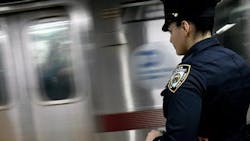USDOT, MTA, GCRTA take steps to improve safety on public transit
The U.S. Department of Transportation (USDOT), the Metropolitan Transportation Authority (MTA) and the Greater Cleveland Regional Transit Authority (GCRTA) are taking steps to improve safety across public transit.
USDOT
In a series of letters on March 6, Transportation Secretary Sean Duffy urged Washington, D.C., Mayor Muriel Bowser, Amtrak CEO Stephen Gardner and Washington Metropolitan Area Transit Authority (WMATA) CEO Randy Clarke to prioritize improvements to passenger security, crime reduction and roadway safety.
“The president has called for people to return to office, and it is critical we ensure workers’ safety during their daily commute,” Duffy said. “That is why I am taking action to direct those responsible for ensuring safety for passengers and workers in D.C. to make necessary improvements and upgrades. Our nation’s capital should be a beacon of safety and cleanliness for all who work, live and visit. This includes reducing crime and fare evasion on the D.C. metro system and bus system to ensure people using public transit feel safe. Making D.C. safe again starts with restoring people’s faith in our transportation systems, and the Department of Transportation intends to use every resource at its disposal to restore public confidence and ensure a safe experience for the millions who visit and work in our capital."
Additional information on the letters includes:
- In the letter to Mayor Bowser, Duffy expressed concern with the District of Columbia’s compliance with various federal safety standards, including the safe and efficient operation of public roadways and the associated right-of-way. Duffy requested Bowser direct the District Department of Transportation Director to submit a written report within 30 days that identifies all potential areas of roadway non-compliance, locations of elevated risk impacting safety for the traveling public and any proposed plans that may need to be reviewed as a result of these concerns. USDOT notes the letter emphasized the safety purpose of traffic control devices such as traffic signs, signals and pavement markings, which is to warn or guide pedestrian and vehicular traffic—and not for other forms of expression.
- In the letter to Gardner, Duffy called on Amtrak to prevent crime and improve its management of Washington’s Union Station. USDOT and the Federal Railroad Administration have also directed Amtrak to submit an updated Crime Prevention Plan within 30 days, including details about coordination with other law enforcement agencies and tracking of security expenditures. USDOT notes the Union Station Redevelopment Corporation oversees day-to-day operations, and Amtrak is expected to cooperate to enhance retail performance and protect the traveling public, allowing all stakeholders to focus on advancing state-of-good-repair projects.
- In the letter to Clarke, Duffy highlighted the need to address fare evasion and reduce crime on the WMATA system to protect the safety and security of riders and workers. USDOT notes the letter directs WMATA to provide information about practices, expenditures and initiatives related to safety and security to the Federal Transit Administration. Duffy also asked Clarke to provide specific information on safety and security programs and strategies and how they are funded. USDOT says federal law allows transit recipients to use both formula funds and capital grants for projects to combat crime and improve safety and security.
MTA
The MTA has seen safety improve on its subway system after implementing the five-point subway safety plan in 2024. The plan was launched by New York Gov. Kathy Hochul, who enlisted a surge in New York State personnel to assist with New York Police Department (NYPD) bag checks, directing the MTA to accelerate camera installation throughout the system and also increase the number of Subway Co-Response Outreach (SCOUT) teams throughout the system.
Earlier this year, Gov. Hochul announced additional steps to increase law enforcement presence, expand public resources and strengthen mental health policies to make the transit system safer. The new measures included partnering with New York City officials to increase NYPD patrols on subway platforms and trains; installing new protective barriers on subway platforms to protect riders, upgrading fare gates and delaying egress on exit gates to help crack down on fare evasion, adding LED lighting throughout stations to increase visibility and updating and strengthening key mental health laws to ensure that New Yorkers with severe mental illness are connected with care.
“Keeping New Yorkers safe is my top priority — and I’ll never stop working to ensure riders can rely on our subways to safely get wherever they need to go,” Gov. Hochul said. “By adding uniformed officers to every train, fortifying our transit infrastructure and expanding mental health outreach, we've made real progress in driving down transit crime. Working in partnership with law enforcement, district attorneys and mental health experts, we're working to make the subways safer for every straphanger.”
MTA notes major transit crimes are down 29 percent, and arrests are up 71 percent year to date due to the initiatives. According to the authority, when looking at the same time period, major transit crimes are down 28 percent from pre-pandemic levels in 2019. MTA says that in the first nine weeks of 2025, New York City is experiencing the lowest number of subway crimes in 30 years, outside of the pandemic, as crime is 55 percent lower than in 2001 and 32 percent lower than in 2013.
MTA Chair and CEO Janno Lieber said, “It’s not a mystery — more cops, more enforcement and more effective mental health outreach and treatment directly cuts down on transit crime. Now we need legal changes proposed by Gov. Hochul that will ensure recidivist criminals aren’t free to keep preying on subway riders.”
MTA notes the five-point plan builds on Gov. Hochul’s investment in safety on the subways, from standing up Safe Options Support (SOS) teams to directing the MTA to install cameras in every subway car. MTA says Gov. Hochul also called on judges to use their expanded discretion to set bail to keep repeat offenders off the streets.
According to the authority, Gov. Hochul is working in partnership with New York City to increase NYPD presence on platforms and trains by temporarily surging patrol levels in addition to the National Guardsmen that have been re-deployed into the transit system. MTA notes that approximately 750 NYPD officers will be stationed across New York City, with an additional 300 in the train cars themselves. MTA says the increase in enforcement will prioritize 30 subway stations and transit hubs that account for 50 percent of crime in the transit system.
Gov. Hochul worked with New York City to increase police patrols on every overnight train for a six- month time period. MTA notes NYPD officers are working from 9:00 p.m. to 5:00 a.m., and there are two uniformed officers onboard every subway train in service during those hours.
This expansion of law enforcement patrols builds on the governor’s previous announcement in December 2024 to add an additional 250 members of the National Guard to support subway safety, bringing the total to 1,000 National Guardsmen stationed at subway entrances in points throughout New York City.
Gov. Hochul will provide the funding to install platform edge barriers at more than 100 additional stations by the end of 2025. MTA says the selection of stations for the installation process will prioritize feasibility, including stations with standard car-stopping positions in segments of the 1, 2, 3, 4, 5, 6, 7, F, M and L trains. Among these train lines, stations with higher ridership levels and island platforms will be prioritized. Gov. Hochul will invest in modern fare gates in more than 20 stations across the system in 2025 and an additional 20 stations in 2026.
MTA says exit gates will delay egress at 150 additional stations in an effort to reduce fare evasion. At the governor’s direction, the MTA will prioritize stations with higher ridership traffic, accessibility features and those with high fare evasion. MTA notes the piloted design used in the rollout was solicited through the MTA’s request for information to qualify the next generation of fare gates across the system. Initial installation is scheduled to begin at 42 St-Port Authority, Delancey St-Essex Street and Roosevelt Avenue-Jackson Heights. The governor will also provide funding to install LED lighting in all subway stations throughout the system, which will increase visibility throughout the stations.
MTA notes Gov. Hochul’s SOS initiative has successfully transitioned nearly 850 unhoused individuals into permanent housing and continues to make progress. According to the authority, SOS teams deployed across New York State often encounter individuals experiencing unmet medical and psychiatric needs. To address the gap, MTA says Gov. Hochul is adding street medicine and street psychiatry providers to SOS teams statewide.
According to the MTA, SOS teams deliver timely care directly to individuals during outreach, improving access to psychiatric evaluations and medical treatment without requiring individuals to leave their belongings or seek care in hospitals. The authority says the approach is enhancing trust, building rapport and encouraging individuals to accept services and transition indoors, improving outcomes for New York’s most vulnerable residents.
To further help reduce homelessness in the subway system, Gov. Hochul is working with the New York City Department of Homeless Services to expand their 24/7 welcome center model near end-of-line stations and will create spaces within stations that have a large presence of unhoused people for mobile outreach teams to better connect and coordinate services. Gov. Hochul previously announced a $20 million investment to expand the SCOUT Teams throughout the system to 10 by the end of 2025 as a part of the five-point plan.
GCRTA
GCRTA has welcomed 14 new transit police officers to its department.
“These new officers bring unique experiences to GCRTA’s transit police, which is immensely valuable in policing,” said GCRTA’s Chief of Police Deirdre Jones. “We are thrilled to have them as part of the team and are excited to see what they accomplish here at GCRTA.”
The agency notes the officers are currently being paired with a field training officer, where they will learn the operational aspects of the job over the next six months. After successful completion, they will receive their assignments.
“This group of men and women gave their all at the Police Academies they attended,” said GCRTA General Manager and CEO India L. Birdsong Terry. “I know we will see that same effort and dedication as they officially join our transit police family and rise in the ranks while performing their duty. Congratulations and welcome aboard.”
About the Author
Brandon Lewis
Associate Editor
Brandon Lewis is a recent graduate of Kent State University with a bachelor’s degree in journalism. Lewis is a former freelance editorial assistant at Vehicle Service Pros in Endeavor Business Media’s Vehicle Repair Group. Lewis brings his knowledge of web managing, copyediting and SEO practices to Mass Transit Magazine as an associate editor. He is also a co-host of the Infrastructure Technology Podcast.

